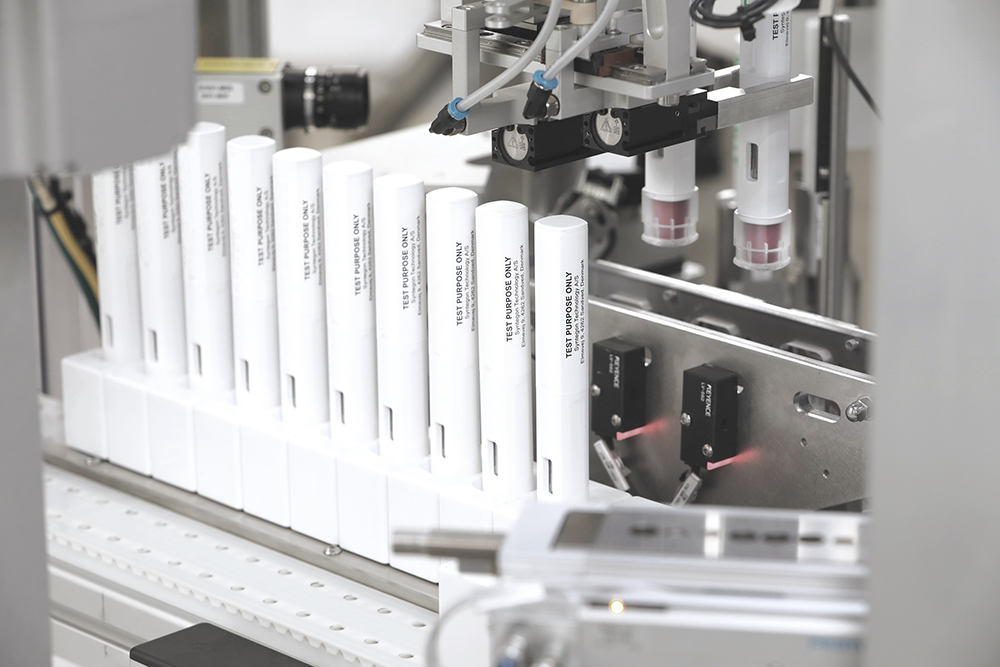To Issue 168
Citation: Brinkrode K, Keldke U, “Efficiently Producing Injectables in Small Batches”. ONdrugDelivery, Issue 168 (Jan 2025), pp 97–99.
Klaus Brinkrode and Ulrik Keldke discuss industry challenges in injectable production – and how to produce small batches of injection devices efficiently .
Efficient and rapid scaling is crucial for injectable device production to keep pace with fluctuating demands. This necessity is fuelled by the drive for faster market entry, a surge in new product launches and the “fail fast” mindset, all of which significantly boost the demand for versatile and scalable manufacturing solutions.
The global injectable drug delivery market is growing rapidly, driven by advancements in biologics and personalised medicine. According to a 2023 report by Markets and Markets, the injectable drug delivery market is projected to reach $902 billion (£711 billion) by 2028, fuelled by the increasing prevalence of chronic diseases, growth in self-administration practices and demand for biologics (Figure 1). This trend underscores the importance of efficient production systems that can cater to varying demands, from large-scale manufacturing to smaller, specialised batches.

Figure 1: Medical devices, such as autoinjectors, safety devices and pens, contribute to beneficial patient outcomes, as they support easy administration and therapy adherence.
Large automated systems, capable of assembling hundreds of pens and autoinjectors per minute, are often the go-to choice for high-volume production. However, such systems may not be ideal for low-volume production runs, such as those needed for clinical trials, specialised medications or early product launches. This gap has led to an increased focus on manual assembly platforms specifically designed for agility and flexibility.
INDUSTRY CHALLENGES IN INJECTABLE PRODUCTION
The production of injectable drugs presents unique challenges, including stringent sterility requirements, complex formulation processes and diverse global regulatory standards. The need to maintain sterility throughout production is paramount, with contamination posing significant risks to patient safety and product efficacy. Additionally, the supply chain for critical components such as vials, syringes and stoppers, has been under strain in recent years, requiring manufacturers to adopt adaptive and resilient strategies.
Small-batch assembly solutions must adhere to stringent regulatory requirements and quality control standards, matching the precision and reliability of their high-capacity automated counterparts. Additionally, these systems should blend automated functions with human interaction, enhancing production efficiency while maintaining safety. Key considerations for such systems include ergonomics, usability and adaptability to new device types from various manufacturers. These features are essential for efficient production transitions and overall versatility in addressing evolving market demands.
“By integrating robust design principles, small-batch systems can facilitate efficient scaling, ensuring consistent quality across all production stages.”
SEAMLESS SCALABILITY ACROSS PRODUCTION STAGES
Pharmaceutical manufacturers and contract development and manufacturing organisations are increasingly recognising the need for a range of production solutions. These include manual platforms that complement high-volume automated assembly systems, providing the flexibility required to produce small batches efficiently. Starting with small clinical trials and advancing to market introduction, such systems support a streamlined ramp-up to full-scale mass production. This approach enables organisations to meet rapidly changing market demands while maintaining regulatory compliance and product quality.
Scalability is a critical factor, as it ensures a seamless transition from clinical stages to commercial scale without the need for extensive revalidation processes. By integrating robust design principles, small-batch systems can facilitate efficient scaling, ensuring consistent quality across all production stages. Real-world examples illustrate the benefits of scalable solutions.
For example, a European biotech firm leveraged modular assembly platforms during the development of a new biologic drug. The initial set-up allowed for small-batch production for clinical trials, which then seamlessly transitioned to higher-output machines as the product moved to commercialisation, reducing time-to-market by 30%.
ENHANCING FLEXIBILITY FOR DIVERSE APPLICATIONS
Modular design is a cornerstone of effective small-batch production systems. This design approach provides the versatility needed to accommodate new devices from various manufacturers, ensuring consistent assembly across different device sizes and types. By adhering strictly to assembly specifications, including precise measurements of distance, force and resistance, these systems can deliver uniform and repeatable outcomes. This modularity also enables operators to execute quick and error-free changeovers, ensuring smooth and efficient transitions between formats or devices.
“The rise of RNA-based therapies has further highlighted the need for flexible production systems.”
The rise of RNA-based therapies has further highlighted the need for flexible production systems. Such therapies often require specialised handling and small-batch production capabilities due to their complexity and cost. Modular systems equipped with advanced monitoring and control technologies can ensure precise assembly and adherence to regulatory standards, even for these cutting-edge applications.
OPERATOR-CENTRIC DESIGN AND EASE OF USE
Ease of operation is a vital consideration for any manual assembly platform. Intuitive interfaces, clear operator guidance and ergonomic designs contribute to enhanced accuracy and efficiency. For example, height-adjustable screens, polycarbonate enclosures for visibility and safety, and angled table plates for effortless component feeding and removal are all features that improve operator engagement. These design elements reduce errors and increase processing speed, ensuring that small-batch production remains both efficient and reliable.
A study by the International Society for Pharmaceutical Engineering in 2022 emphasised the importance of operator-centric design in minimising human error. Systems that integrate advanced human-machine interfaces and ergonomic features can lead to a 25% reduction in operational errors, improving overall equipment effectiveness (OEE) and product quality (Figure 2).

Figure 2: Systems that integrate advanced human-machine interfaces and ergonomic features can lead to a 25% reduction in operational errors.
MAINTAINING HIGH EQUIPMENT EFFECTIVENESS
High OEE is another important goal for small-batch production systems. Features such as lifetime lubrication on actuators, drives and gears can minimise maintenance requirements, allowing operators to focus on achieving optimal performance. Additionally, systems designed for easy monitoring and reporting enhance traceability and compliance with industry standards such as CFR 21 Part 11.
Automation in monitoring and reporting is also advancing rapidly. For instance, integrated batch reporting systems that track variables such as force and distance can ensure traceability and facilitate compliance with stringent regulatory requirements. This capability is particularly crucial for biologics and other high-value injectable products, where consistency and reliability are non-negotiable.
MEETING THE NEEDS OF A DYNAMIC MARKET
As the pharmaceutical industry continues to evolve, the demand for flexible, scalable and efficient production solutions grows increasingly important. Small-batch assembly platforms that integrate advanced design principles and operator-focused features are becoming essential for meeting the dynamic needs of the market. These systems enable rapid changeovers, allowing manufacturers to switch between device formats with minimal downtime, ensuring efficient responses to shifting market demands while maintaining high standards of quality and compliance.
“The future of injectable drug production lies in adaptability, precision and cutting-edge technology.”
The future of injectable drug production lies in adaptability, precision and cutting-edge technology. Innovations such as integrated batch reporting systems offer unparalleled traceability, meeting stringent regulatory standards effortlessly. As the industry moves forward, advancements in artificial intelligence and robotics, including predictive maintenance tools and real-time quality control systems, promise to further enhance the efficiency and reliability of injectable production systems. These developments will continue to empower manufacturers to meet the evolving demands of the injectable drug market, ultimately contributing to improved patient care and more efficient healthcare delivery.

